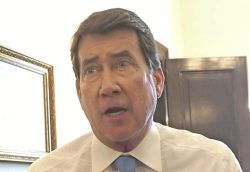U.S. Monetary Policy: Prospect of September Rate Cut by Federal Reserve Roils Market
17:09 JST, August 3, 2024
As the U.S. Federal Reserve Board’s monetary tightening policy nears a turning point, financial market volatility is intensifying, as seen in the Nikkei Stock Average’s recent plunge of about 2,200 points.
It is hoped that the Fed will steer its monetary policy appropriately. In addition, the Japanese government and the Bank of Japan need to be vigilant about market developments.
The Fed has decided to leave its policy rate unchanged in a range of 5.25% to 5.5% per year. This is the eighth consecutive meeting since September last year that the central bank has decided to hold the rate.
At the same time, Fed Chair Jerome Powell clearly said at a press conference that an interest rate cut “could be on the table at the September meeting.” He may be judging that a way out is in sight in the long battle against inflation.
The U.S. economy experienced historically high inflation, with the consumer price index rising over 9% in June 2022 mainly due to supply constraints in the COVID-19 pandemic. As a result of the Fed raising interest rates to calm down inflation, the rate of CPI increase fell to 3% in June this year.
Monetary policy is said to have a clear effect on the economy six months or more into the future, and it is difficult to judge when to start cutting interest rates. If financial authorities become too cautious about cutting interest rates to prevent a resurgence of inflation, it could trigger a recession.
The United States’ real gross domestic product for the April-June 2024 period was robust, growing at an annualized rate of 2.8% compared with the previous quarter. However, the index of business confidence in the manufacturing industry has recently deteriorated, and the number of new applications for unemployment insurance is also at a high level.
For this reason, the Dow Jones Industrial Average of the New York Stock Exchange temporarily dropped over 700 points on Aug. 1, as speculation of an economic slowdown increased in the financial markets.
The Fed will likely assess the extent of the risk of a serious economic slowdown and consider how to cut interest rates in the future.
Concerns about the U.S. economy have spread to Japan as well. The Nikkei Stock Average closed below 36,000, down 2,216 points, on Aug. 2. In terms of points, the steep decline marked the second largest in history.
Since reaching an all-time high of 42,224 on July 11, the Nikkei Stock Average has dropped more than 6,000 points in about three weeks.
The yen has appreciated against the dollar due to the BOJ’s decision at the end of July to raise interest rates and other factors. Therefore, the view that earnings will deteriorate, especially among export-oriented companies, has led to the decline in stock prices.
Correcting the excessive depreciation of the yen against the dollar is desirable. However, as the interest rate differential between Japan and the United States, which has brought about the yen’s depreciation to date, narrows, the yen could appreciate beyond expectations.
It is important for the BOJ to keep an eye on developments in the U.S. economy and financial markets, and to flexibly manage its monetary policy.
(From The Yomiuri Shimbun, Aug. 3, 2024)
"Editorial & Columns" POPULAR ARTICLE
-

Artificial Intelligence Expands Possibilities for Foreign Language Learners
-

Build Intellectual, Physical Strength, As Well As Communicative Power / Japan Should Move from Beneficiary to Shaper of World Order
-

Global Economy in Turmoil: Prevent Free Trade System from Going Adrift / Risks to Financial Markets Must Be Heeded
-

Japan-China Strain Set to Persist as Beijing Officials Self-Interestedly Bash Tokyo; Takaichi Unlikely to Back Down
-

Elderly People Living Alone: What Should be Done to Ensure Living with Peace of Mind until the End?
JN ACCESS RANKING
-

BOJ Gov. Ueda: Highly Likely Mechanism for Rising Wages, Prices Will Be Maintained
-

Japan Govt Adopts Measures to Curb Mega Solar Power Plant Projects Amid Environmental Concerns
-

Core Inflation in Tokyo Slows in December but Stays above BOJ Target
-

Major Japan Firms’ Average Winter Bonus Tops ¥1 Mil.
-

Bank of Japan Considered U.S. Tariffs, Coming Shunto Wage Hike Talks in Its Decision to Raise Interest Rates

























